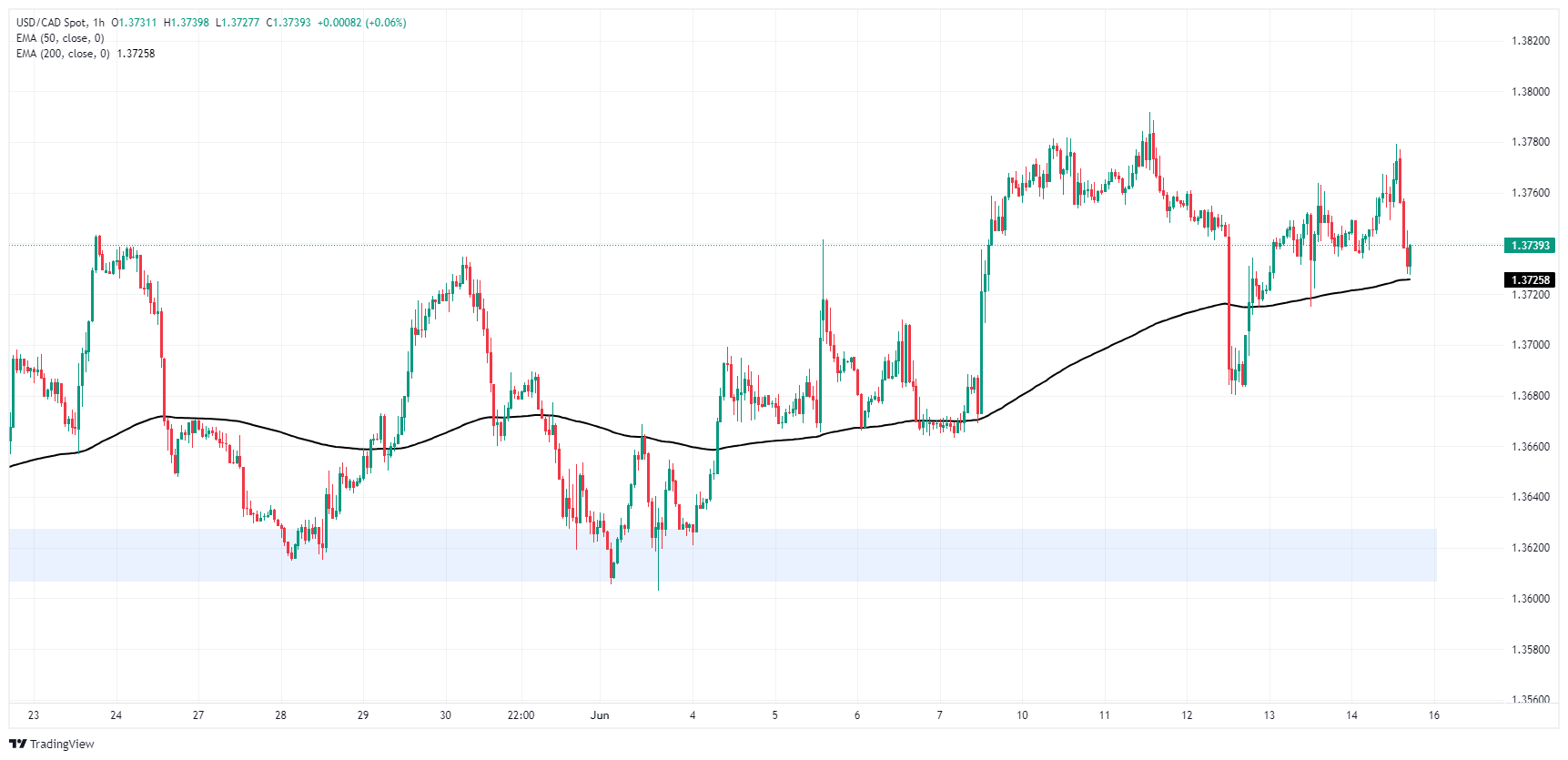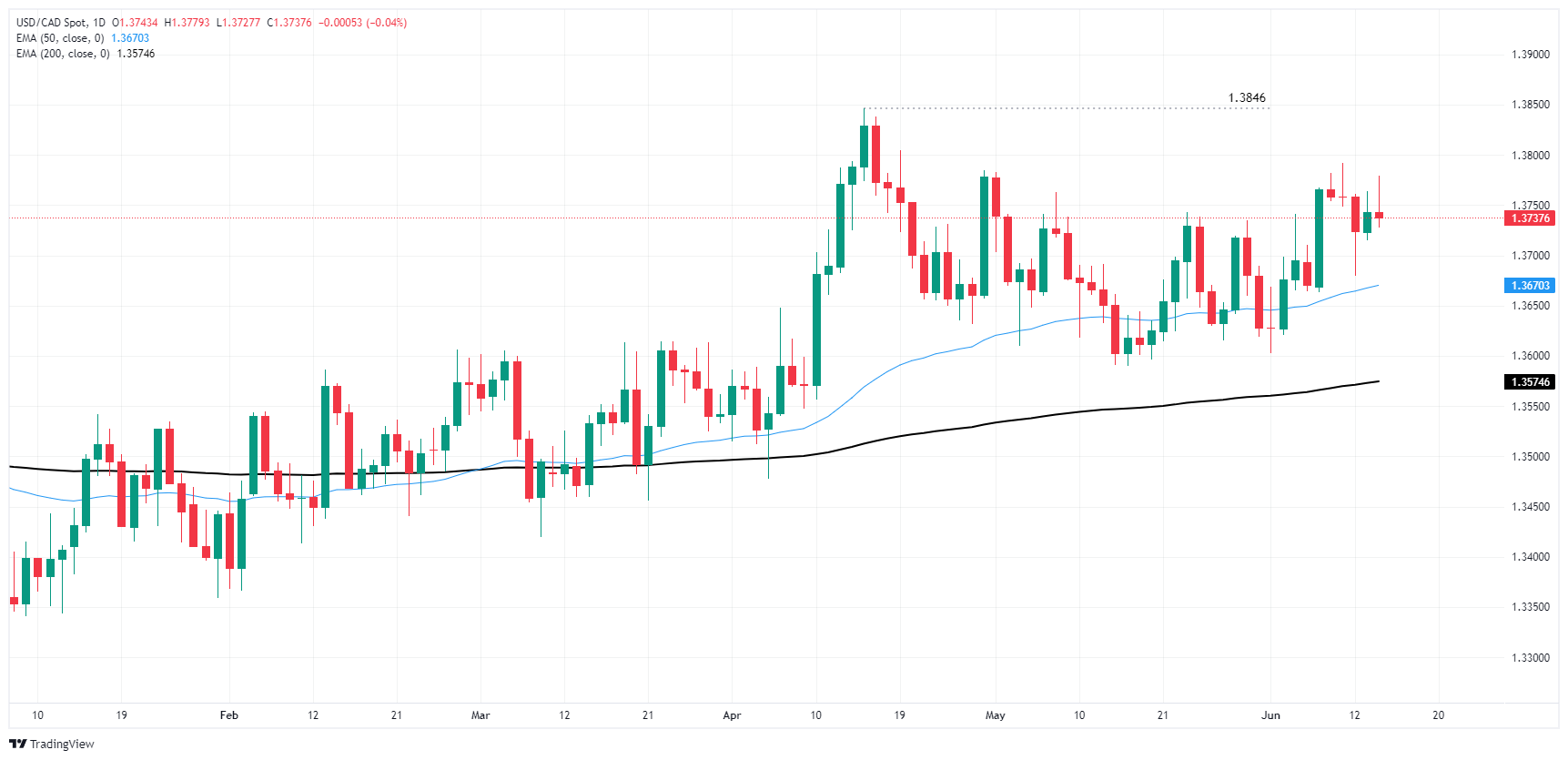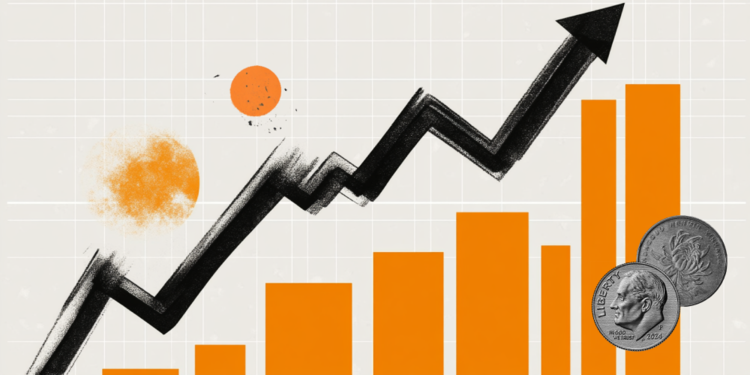- The Canadian dollar rises broadly on Friday, but only slightly.
- Canada’s manufacturing and wholesale sales figures disappointed expectations.
- The US Consumer Sentiment survey dominates the news flow in the American session.
He Canadian dollar (CAD) found a slight recovery on Friday, gaining ground against most of its major currency pairs and recovering a scant tenth of a percentage point against the US Dollar (USD). A failed forecast in Canadian Manufacturing Sales was widely ignored, and an unexpected pullback in the University of Michigan (UoM) Consumer Sentiment is throwing a warning on market sentiment to close out the trading week.
Manufacturing and wholesale sales in Canada saw a milder recovery from recent contractions than expected, but market sentiment is largely focused elsewhere after the UoM consumer sentiment index fell to a six-month minimum, and 5-year consumer inflation expectations will increase in June.
Daily movements and market drivers: Canadian dollar makes slight gains despite failed forecast
- Canadian manufacturing sales rebounded 1.1% mom in April, slightly below the forecast of 1.2% and recovering from the previous month’s revised -1.8%.
- Wholesale sales recovered 2.4% in the same period, but did not reach the expected 2.8%. Wholesale sales provided a firmer recovery from -1.3% previously, which was also revised slightly downward from -1.1%.
- The UoM Consumer Sentiment Index unexpectedly declined in June, falling to 65.6 after markets expected a rise to 72.0 from 69.1 previously. The decline represents the worst figure for the key sentiment indicator in six months.
- UoM 5-year consumer inflation expectations also rose in June, rising to 3.1% from 3.0% previously. According to the UoM consumer survey, consumer expectations about future inflation have risen to their second highest level since the Covid pandemic era.
- Next week, Canadian data continues to play a secondary role, restricted to mid-level releases at most throughout the week. US Retail Sales will be a key release on Tuesday.
Price of the Canadian Dollar Today
The table below shows the percentage change of the Canadian Dollar (CAD) against the major currencies listed today. The Canadian Dollar was the strongest against the British Pound.
| USD | EUR | GBP | JPY | CAD | AUD | NZD | CHF | |
|---|---|---|---|---|---|---|---|---|
| USD | 0.36% | 0.61% | 0.17% | -0.01% | 0.34% | 0.49% | -0.45% | |
| EUR | -0.36% | 0.26% | -0.17% | -0.39% | -0.03% | 0.13% | -0.80% | |
| GBP | -0.61% | -0.26% | -0.42% | -0.63% | -0.27% | -0.13% | -1.05% | |
| JPY | -0.17% | 0.17% | 0.42% | -0.19% | 0.16% | 0.30% | -0.60% | |
| CAD | 0.01% | 0.39% | 0.63% | 0.19% | 0.36% | 0.49% | -0.43% | |
| AUD | -0.34% | 0.03% | 0.27% | -0.16% | -0.36% | 0.14% | -0.80% | |
| NZD | -0.49% | -0.13% | 0.13% | -0.30% | -0.49% | -0.14% | -0.92% | |
| CHF | 0.45% | 0.80% | 1.05% | 0.60% | 0.43% | 0.80% | 0.92% |
The heat map shows the percentage changes of the major currencies against each other. The base currency is chosen from the left column, while the quote currency is chosen from the top row. For example, if you choose the Canadian Dollar from the left column and move along the horizontal line to the US Dollar, the percentage change shown in the box will represent CAD (base)/USD (quote).
Technical Analysis: Volatile trading continues to weigh on the Canadian dollar
The Canadian Dollar (CAD) rises broadly on Friday, shrugging off a half-percent drop against the Swiss Franc (CHF) to rise six-tenths of a percentage point against the British Pound (GBP) and four-tenths of a percentage point against the Euro ( EUR) and the New Zealand Dollar (NZD). The CAD is struggling to maintain near-term gains against the US Dollar, trading within a tenth of a percentage point of Friday’s opening bids.
USD/CAD rose to the 1.3780 region on Friday before retreating to familiar territory below 1.3740. The pair continues to trade above the 200 hourly EMA, but volatility remains high. Consolidation continues to weigh on the daily candlesticks, although USD/CAD has managed to trade on the north side of the 200-day EMA at 1.3575 since early April.
Near-term momentum is tilting in favor of the bears as sellers look set to drag USD/CAD back to the 50-day EMA at 1.3670 unless renewed buying pressure pushes the pair above the June high bids near 1.3790.
USD/CAD Hourly Chart
USD/CAD Daily Chart
The Canadian dollar
The key factors that determine the price of the Canadian Dollar (CAD) are the level of interest rates set by the Bank of Canada (BoC), the price of oil, Canada’s main export product, the health of its economy, inflation and the trade balance, which is the difference between the value of Canadian exports and its imports. Other factors are market confidence, that is, whether investors bet on riskier assets (risk-on) or look for safe assets (risk-off), with the risk-on being positive for the CAD. As its largest trading partner, the health of the US economy is also a key factor influencing the Canadian dollar.
The Bank of Canada (BoC) exerts significant influence over the Canadian Dollar by setting the level of interest rates that banks can lend to each other. This influences the level of interest rates for everyone. The BoC’s main objective is to keep inflation between 1% and 3% by adjusting interest rates up or down. Relatively high interest rates are usually positive for the CAD. The Bank of Canada can also use quantitative easing and tightening to influence credit conditions, with the former being negative for the CAD and the latter being positive for the CAD.
The price of oil is a key factor influencing the value of the Canadian Dollar. Oil is Canada’s largest export, so the price of oil tends to have an immediate impact on the value of the CAD. Generally, if the price of oil rises, the CAD also rises, as aggregate demand for the currency increases. The opposite occurs if the price of oil falls. Higher oil prices also tend to lead to a higher probability of a positive trade balance, which also supports the CAD.
Although inflation has traditionally always been considered a negative factor for a currency, as it reduces the value of money, the opposite has actually happened in modern times, with the relaxation of cross-border capital controls. Higher inflation often leads central banks to raise interest rates, attracting more capital inflows from global investors looking for a lucrative place to store their money. This increases the demand for the local currency, which in the case of Canada is the Canadian Dollar.
The published macroeconomic data measures the health of the economy and may have an impact on the Canadian dollar. Indicators such as GDP, manufacturing and services PMIs, employment and consumer confidence surveys can influence the direction of the CAD. A strong economy is good for the Canadian dollar. Not only does it attract more foreign investment, but it may encourage the Bank of Canada to raise interest rates, resulting in a stronger currency. However, if economic data is weak, the CAD is likely to fall.
Source: Fx Street
I am Joshua Winder, a senior-level journalist and editor at World Stock Market. I specialize in covering news related to the stock market and economic trends. With more than 8 years of experience in this field, I have become an expert in financial reporting.







